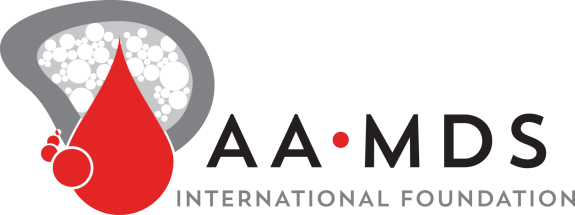Grants and Grant Recipients
Since 1989, AAMDSIF has provided research grants totaling in excess of $5.9 million to an international group of 107 researchers
The two-year grants have helped bring forth new insights into the causes and therapeutic approaches for these diseases. These grantee profiles present the grantees by year the awards were granted, and a summary of their grant-funded research projects.
Grant Year: 2013
Rosario Notaro, MD
Amber Lynn Wakefield Research Fund
Aplastic anemia and Paroxysmal
Nocturnal Hemoglobinuria (PNH) are two serious blood disorders that share one
important feature: the bone marrow
cannot always keep up with the body’s needs for blood cells. We call this feature bone marrow failure
(BMF); it means that there may be anemia, low white cells (particularly
neutropenia, entailing the risk of infection), low platelets (with risk of
bleeding). Recently we have analyzed in
depth a type of lymphocyte cells called T cells in patients with PNH, and we
have found that they have an excess of a very rare subset of T cells that are
able to recognize a specific glycolipid molecule (a molecule that contains both
a sugar moiety and a fat moiety) – we have called them GPI-reactive T
cells. We now plan to...
Eirini Papapetrou, MD, PhD
Research is Hope Fund
Progress in understanding the
etiology and effective treatment of MDS is currently hampered by the scarcity
of tools to study this disease. Our goal
is to harness cutting-edge human pluripotent stem cell and genetic
engineering technologies to establish
new models of an MDS subset characterized by loss of chromosome 7 material and
use them as a novel platform to identify genes on chromosome 7 that are
critical for this disease. These models
should provide a powerful resource to the MDS community to investigate the cell
biology, molecular pathogenesis and genetic basis of MDS, identify new
therapeutic targets and perform drug screens.
Read more about this study.
Akiko Shimamura, MD, PhD
Torry Yahn Research Fund
Currently aplastic anemia is treated
with immunosuppressive therapy (IST) or a bone marrow transplant. Approximately 30% of aplastic anemia patients
treated with IST are refractory to treatment or develop myelodysplastic
syndromes (MDS) and leukemia. Tests to
predict which patients will fare poorly to immunosuppressive therapy would
inform upfront treatment decisions. We
will utilize cutting edge genomic technologies to screen for genetic markers
predictive of poor outcomes with IST.
This study will develop a novel diagnostic tool for aplastic anemia to
guide treatment decisions with the goal of improving patient survival.
Grant Year: 2012
David Araten, MD
PNH Research and Support Foundation
Paroxysmal Nocturnal Hemoglobinuria (PNH) is a disorder in which bone marrow failure is an important feature. The bone marrow failure in PNH is similar or identical to that which occurs in aplastic anemia. However, PNH has a few other features, some of which are well understood and some of which are not . One of the features that is not well understood in PNH includes the expansion of an abnormal stem cell clone in the bone marrow (called clonal expansion) which can by itself provide a very large percentage of the patient's blood cells. This clone has as its feature the presence of a mutation in a gene called PIG-A. Different patients have different types of mutations in this gene, but it is always in this gene. It has long been suspected that there may be other genes...
Lisa Minter, PhD
Caitlyn Langley Research Fund, Holly Cataldo Research Fund
Jeffrey Pu, MD, PhD
PNH Research and Support Foundation
Acquired bone marrow failure diseases include myelodysplastic
syndrome (MDS), acquired aplastic anemia (AA), and paroxysmal nocturnal
hemoglobinuria (PNH). PNH is a clonal disorder originating from a multipotent
hematopoietic stem cell (HSC) acquiring a PIG-A
gene mutation. PIG-A mutations lead
to the absence of glycosylphosphatidylinositol-anchor proteins (GPI-AP), which
contributes to many manifestations of PNH. About 25% of MDS patients and 60% of
AA patients also harbor small populations of PNH-like cells (0.01-10%). It was
observed that: 1) 10-20% of AA patients harboring PNH-like cells eventually
transform into PNH, but MDS patients seldom evolve to PNH; 2) AA patients harboring
PNH-like cells may have a better response to immunosuppressive therapy; 3) PIG-A mutation...
Matthew J. Walter, MD
Research is Hope Fund
The
genes responsible for MDS initiation are largely unknown. Recently, a group of
genes that are important for splicing together RNA in cells were found to be
mutated in up to 57% of MDS patients. How these mutations contribute to MDS
initiation is unknown. We will determine whether a mutation in one of these
genes (U2AF1) affects blood cell formation in mice and alters the splicing of
RNA in bone marrow cells from mice and MDS patients.
Zhe Yang, PhD
Harold Spielberg Research Fund
Dr. Yang's project is Structural insights into deregulated epigenetic mechanisms and DNA demethylation in MDS. The exciting new discovery of frequent Tet2 mutation in a wide range of myeloid malignancies including myelodysplastic syndromes (MDS) highlights the clinical significance of this myeloid relevant protein with potential applications to disease diagnosis, treatment, and prognosis. Successful completion of this project that focuses on Tet2 structure and function will be important for unraveling the structural basis of MDS at the molecular level, providing a framework for understanding how pathological Tet2 mutations cause MDS, and most importantly, will potentially open avenues to novel therapeutic strategies to ameliorate a variety of myeloid disorders including MDS.
"This...
Grant Year: 2011
Kim-Hien T. Dao, DO, PhD
Torry Yahn Research Fund
Dr. Dao will investigate why the blood stem cells from patients who inherit a loss-of-function mutation in one of the genes of the Fanconi anemia pathway are highly susceptible to cell death yet also highly susceptible to conversion into an acute leukemia.
Keith McCrae, MD
PNH Research and Support Foundation
Dr. McCrae's study explores why patients with PNH are at increased risk for the development of thrombosis, or blood clots, that may affect arteries or veins and cause events such as pulmonary emboli or stroke.











